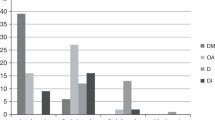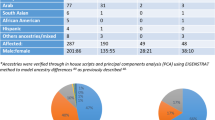Abstract
Wolfram syndrome, a rare autosomal recessive neurodegenerative disorder, was originally described as a combination of familial juvenile-onset diabetes mellitus and optic atrophy. It was later demonstrated that Wolfram syndrome patients were highly prone to psychiatric disorders. Mutations in exon 8 of the Wolfram syndrome gene account for 88% of the patients with Wolfram syndrome. To examine whether the gene responsible for causing Wolfram syndrome is involved in psychiatric disorders, we screened exon 8 of the Wolfram syndrome gene for mutations in 119 patients with schizophrenia, one patient with schizoaffective disorder, 12 patients with bipolar disorder and 15 patients with major depression, using sequence analysis. In Wolfram syndrome patients, this gene has been shown to have primarily nonsense or frameshift mutations, which would result in a premature truncation of the protein. None of the psychiatric patients screened in this study carried these types of mutations. We identified, however, 24 new variations whose significance remains to be determined.
This is a preview of subscription content, access via your institution
Access options
Subscribe to this journal
Receive 12 print issues and online access
$259.00 per year
only $21.58 per issue
Buy this article
- Purchase on Springer Link
- Instant access to full article PDF
Prices may be subject to local taxes which are calculated during checkout

Similar content being viewed by others
References
Wolfram DJ, Wagner HP . Diabetes mellitus and simple optic atrophy among siblings: report of four cases Mayo Clin Proc 1938 13: 715–718
Shaw DA, Duncan LJP . Optic atrophy and nerve deafness in diabetes mellitus J Neurol Neurosurg Psychiat 1958 21: 47–49
Dreyer M, Rudiger HW, Bujara K, Herberhold C, Kuhnau J, Maack P et al. The syndrome of diabetes insipidus, diabetes mellitus, optic atrophy, deafness, and other abnormalities (DIDMOAD-syndrome). Two affected sibs and a short review of the literature (98 cases) Klin Wochenschr 1982 60: 471–475
Swift RG, Sadler DB, Swift M . Psychiatric findings in Wolfram syndrome homozygotes Lancet 1990 336: 667–669
Swift RG, Perkins DO, Chase CL, Sadler DB, Swift M . Psychiatric disorders in 36 families with Wolfram syndrome Am J Psychiatry 1991 148: 775–779
Swift RG, Polymeropoulos MH, Torres R, Swift M . Predisposition of Wolfram syndrome heterozygotes to psychiatric illness Mol Psychiatry 1998 3: 86–91
Inoue H, Tanizawa Y, Wasson J, Behn P, Kalidas K, Bernal-Mizrachi E et al. A gene encoding a transmembrane protein is mutated in patients with diabetes mellitus and optic atrophy (Wolfram syndrome) Nat Genet 1998 20: 143–148
Strom TM, Hortnagel K, Hofmann S, Gekeler F, Scharfe C, Rabl W et al. Diabetes insipidus, diabetes mellitus, optic atrophy and deafness (DIDMOAD) caused by mutations in a novel gene (wolframin) coding for a predicted transmembrane protein Hum Mol Genet 1998 7: 2021–2028
Hardy C, Khanim F, Torres R, Scott-Brown M, Seller A, Poulton J et al. Clinical and molecular genetic analysis of 19 Wolfram syndrome kindreds demonstrating a wide spectrum of mutations in WFS1 Am J Hum Genet 1999 65: 1279–1290
Nurnberger JI Jr, Blehar MC, Kaufmann CA, York-Cooler C, Simpson SG, Harkavy-Friedman J et al. Diagnostic interview for genetic studies. Rationale, unique features, and training. NIMH Genetics Initiative Arch Gen Psychiatry 1994 51: 849–859; discussion 863–864
American Psychiatric Association . Diagnostic and Statistical Manual of Mental Disorders, revised 3rd edn American Psychiatric Press: Washington, DC 1987
American Psychiatric Association . Diagnostic and Statistical Manual of Mental Disorders, revised 4th edn American Psychiatric Press: Washington, DC 1994
Spitzer RL, Williams JB, Gibbon M, First MB . The Structured Clinical Interview for DSM-III-R (SCID). I: History, rationale, and description Arch Gen Psychiatry 1992 49: 624–629
Lyamichev V, Mast AL, Hall JG, Prudent JR, Kaiser MW, Takova T et al. Polymorphism identification and quantitative detection of genomic DNA by invasive cleavage of oligonucleotide probes Nat Biotechnol 1999 17: 292–296
Furlong RA, Ho LW, Rubinsztein JS, Michael A, Walsh C, Paykel ES et al. A rare coding variant within the wolframin gene in bipolar and unipolar affective disorder cases Neurosci Lett 1999 277: 123–126
Rost B, Fariselli P, Casadio R . Topology prediction for helical transmembrane proteins at 86% accuracy Protein Sci 1996 5: 1704–1718
Acknowledgements
We thank Dr Graeme Bilbe from Novartis Pharma AG, Basel, Switzerland for sharing with us the DNA samples from the NIMH Cell Repository, Bethesda, Maryland, USA.
Author information
Authors and Affiliations
Corresponding author
Rights and permissions
About this article
Cite this article
Torres, R., Leroy, E., Hu, X. et al. Mutation screening of the Wolfram syndrome gene in psychiatric patients. Mol Psychiatry 6, 39–43 (2001). https://doi.org/10.1038/sj.mp.4000787
Received:
Revised:
Accepted:
Published:
Issue Date:
DOI: https://doi.org/10.1038/sj.mp.4000787
Keywords
This article is cited by
-
Modeling disrupted synapse formation in wolfram syndrome using hESCs-derived neural cells and cerebral organoids identifies Riluzole as a therapeutic molecule
Molecular Psychiatry (2023)
-
Dopamine–prolactin pathway potentially contributes to the schizophrenia and type 2 diabetes comorbidity
Translational Psychiatry (2016)
-
Molecular investigation of WFS1 gene exon 8 in Iranian patients with Wolfram syndrome
International Journal of Diabetes in Developing Countries (2016)
-
Phenotype Prediction of Pathogenic Nonsynonymous Single Nucleotide Polymorphisms in WFS1
Scientific Reports (2015)
-
WFS1 variants in Finnish patients with diabetes mellitus, sensorineural hearing impairment or optic atrophy, and in suicide victims
Journal of Human Genetics (2013)



